For the 2025 school year, there is 1 public preschool serving 518 students in Bradford Area School District.
Public Preschools in Bradford Area School District have a diversity score of 0.17, which is less than the Pennsylvania public preschool average of 0.70.
Minority enrollment is 9% of the student body (majority Black and Hispanic), which is less than the Pennsylvania public preschool average of 55% (majority Black and Hispanic).
Overview
This School District
This State (PA)
# Schools
4 Schools
328 Schools
# Students
2,291 Students
147,214 Students
# Teachers
174 Teachers
11,259 Teachers
Student : Teacher Ratio
13:1
13:1
District Rank
Bradford Area School District, which is ranked within the top 50% of all 675 school districts in Pennsylvania (based off of combined math and reading proficiency testing data) for the 2021-2022 school year.
The school district's graduation rate of 80-84% has decreased from 85-89% over five school years.
Overall District Rank
#301 out of 684 school districts
(Top 50%)
(Top 50%)
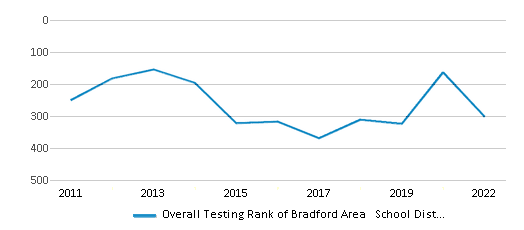
Math Test Scores (% Proficient)
36%
36%
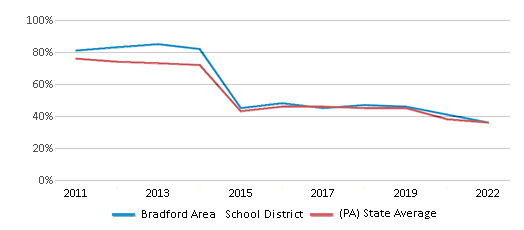
Reading/Language Arts Test Scores (% Proficient)
58%
55%
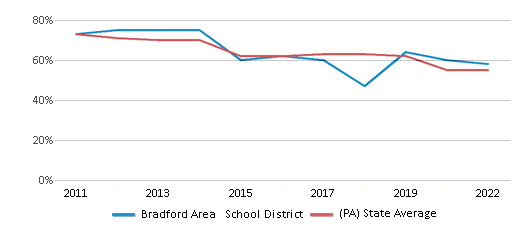
Science Test Scores (% Proficient)
63%
57%
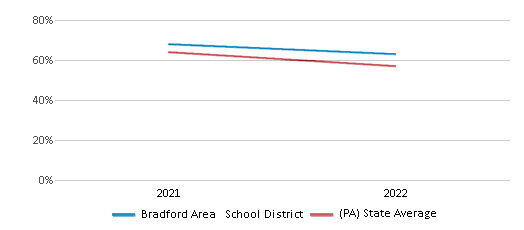
Graduation Rate
80-84%
87%
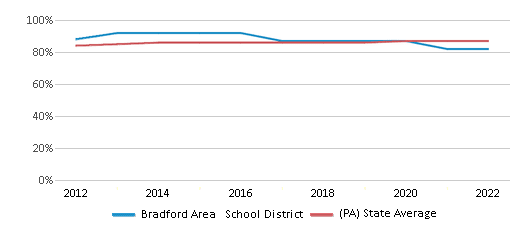
Students by Ethnicity:
Diversity Score
0.15
0.70
# American Indian Students
7 Students
267 Students
% American Indian Students
n/a
n/a
# Asian Students
6 Students
4,636 Students
% Asian Students
n/a
3%
# Hispanic Students
52 Students
31,371 Students
% Hispanic Students
2%
21%
# Black Students
34 Students
35,365 Students
% Black Students
2%
24%
# White Students
2,117 Students
65,860 Students
% White Students
93%
45%
# Hawaiian Students
5 Students
108 Students
% Hawaiian Students
n/a
n/a
# Two or more races Students
70 Students
9,607 Students
% of Two or more races Students
3%
7%
Students by Grade:
# Students in PK Grade:
62
8,317
# Students in K Grade:
129
24,393
# Students in 1st Grade:
163
20,742
# Students in 2nd Grade:
164
21,144
# Students in 3rd Grade:
157
18,141
# Students in 4th Grade:
179
18,415
# Students in 5th Grade:
162
14,862
# Students in 6th Grade:
179
6,743
# Students in 7th Grade:
183
4,529
# Students in 8th Grade:
177
4,525
# Students in 9th Grade:
199
1,699
# Students in 10th Grade:
195
1,361
# Students in 11th Grade:
166
1,242
# Students in 12th Grade:
176
1,101
# Ungraded Students:
-
-
District Revenue and Spending
The revenue/student of $19,098 in this school district is less than the state median of $23,696. The school district revenue/student has grown by 9% over four school years.
The school district's spending/student of $17,765 is less than the state median of $23,119. The school district spending/student has grown by 9% over four school years.
Total Revenue
$44 MM
$39,541 MM
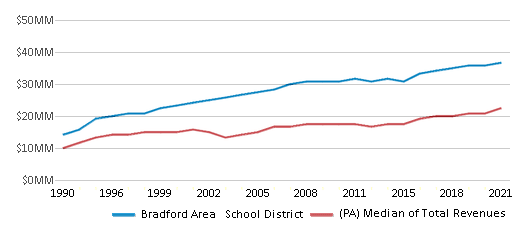
Spending
$41 MM
$38,578 MM
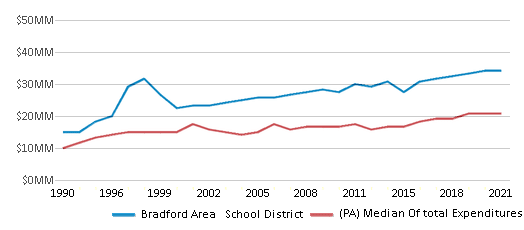
Revenue / Student
$19,098
$23,696

Spending / Student
$17,765
$23,119
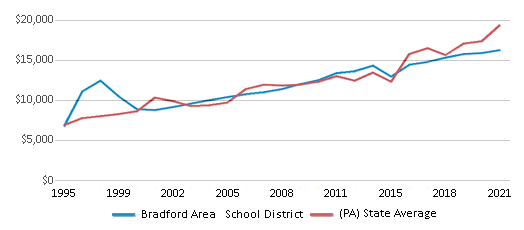
Best Bradford Area School District Public Preschools (2025)
School
(Math and Reading Proficiency)
(Math and Reading Proficiency)
Location
Grades
Students
Rank: n/an/a
265 Constitution Ave
Bradford, PA 16701
(814) 362-6834
Bradford, PA 16701
(814) 362-6834
Grades: PK-2
| 518 students
Recent Articles

What Is A Charter School?
Explore the world of charter schools in this comprehensive guide. Learn about their history, how they operate, and the pros and cons of this educational innovation. Discover key facts about charter schools, including admission policies, demographics, and funding, as well as what to look for when considering a charter school for your child.

10 Reasons Why High School Sports Benefit Students
Discover the 10 compelling reasons why high school sports are beneficial for students. This comprehensive article explores how athletics enhance academic performance, foster personal growth, and develop crucial life skills. From improved fitness and time management to leadership development and community representation, learn why participating in high school sports can be a game-changer for students' overall success and well-being.

February 05, 2025
Understanding the U.S. Department of Education: Structure, Impact, and EvolutionWe explore how the Department of Education shapes American education, from its cabinet-level leadership to its impact on millions of students, written for general audiences seeking clarity on this vital institution.





